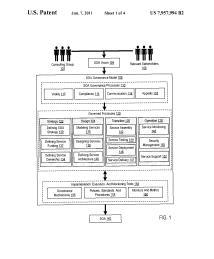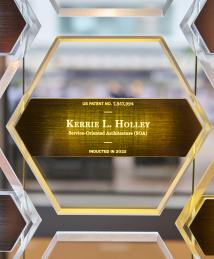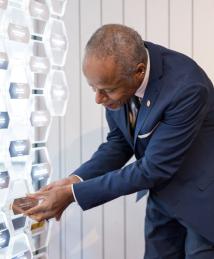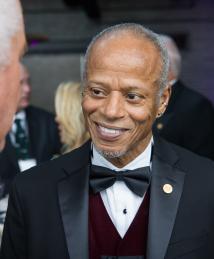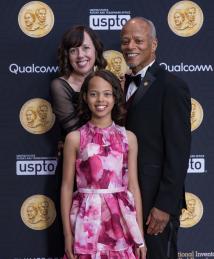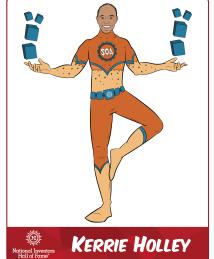Kerrie Holley
"I've been an active engineer and innovator through every era of computing, and I've been excited about each era."
Kerrie Holley pioneered service-oriented architecture (SOA), a software architecture and programming model for large enterprises. Guiding the creation and use of business processes, packaged as services, and defining the information technology (IT) infrastructure that allows applications to participate in these processes, SOA has benefited organizations across many industries. SOA is a precursor to cloud services.
Born in 1954, Holley grew up on Chicago’s South Side, in an area known for widespread poverty and gang violence. He was raised by his grandmother, who prioritized his safety. “When you grow up in an environment where safety is a paramount concern, you think differently about problems,” Holley said in an interview with the National Inventors Hall of Fame®. “That thinking has shaped my life.”
Holley learned to set goals and build perseverance early in life. For many years, he spent his afterschool time at the Sue Duncan Children’s Center, which was run by the mother of future U.S. Secretary of Education Arne Duncan. Duncan refers to Holley as his first mentor. At the center, Holley tutored children and developed a love of mathematics. He learned about computers and programming as a teen, and by age 14, at the dawn of the modern computing era, he wrote his first computer program.
At DePaul University, Holley earned his bachelor’s degree in mathematics in 1976, and in 1982, he earned his law degree from the DePaul University College of Law. Though he would remain involved with DePaul, later serving on the College of Computing and Digital Media leadership council and the university’s board of trustees, Holley set off to pursue his dreams in California. “It was January of '83. We had just come off a blizzard, [and] I had a scheduled trip to Los Angeles,” he recalled. “I drove up to San Francisco, checked it out, and in December of that same year I was living in San Francisco.”
In 1986 Holley joined IBM, kicking off a career that would span the next three decades. He swiftly distinguished himself through his ability to tackle complex technological challenges, consistently delivering innovative solutions that pushed the boundaries of software architecture and design. Holley's unique blend of deep technical knowledge, creative problem-solving skills and strategic foresight enabled him to architect groundbreaking systems that addressed critical business needs while setting new industry standards for elegance and efficiency. “My first project at IBM catapulted my career,” Holley said. “It was 1986, and I was asked to go to Wells Fargo. They had just bought a lot of IBM hardware, and they needed to build new systems – specifically a new banking and sales platform. We started in May and the systems needed to be operational by December. A lot of people at IBM didn't believe it could be done. I was young, brash and pretty good at the various technologies at play, and I was confident it could be done. We were very successful, and I'm still pleased with that outcome.”
Following this early success, Holley introduced several groundbreaking technological advancements, from creating the first e-commerce site for a major retailer to developing a patent for providing recovery assistance for misplaced or stolen mobile devices. One of his most impactful contributions in technology was the creation of IBM’s strategy for SOA.
Prior to Holley’s development of SOA, applications needed to be “hard-wired” together. This was a cumbersome and costly approach, and it impeded innovation. In contrast, SOA turns application portfolios into tools that work like building blocks – they can be arranged and rearranged to create new applications. This allows for “future-proofing,” ensuring that organizations can respond swiftly to changing technology needs by restructuring software into new solutions, rather than making expensive and risky rewrites of application software.
“One of the things that's been problematic in software development for decades has been the ability to build something once and not have to tear it down when new changes come about,” Holley explained. The only real limits on what can be done with SOA are in the builder’s vision because the technology itself no longer presents rigidity or incompatibility. SOA makes technology a flexible instrument of business strategy.
By 2007, SOA had been adopted by half the world’s 30 largest electronics companies; the world’s 10 largest auto manufacturers; the world’s 10 largest banks; the world’s 10 largest telecommunications companies; eight of the world’s 10 largest insurers; four of the world’s 10 largest retailers; 80% of the largest American healthcare providers; and most federal government agencies.
In 2000, Holley became the first Black engineer to be named an IBM Distinguished Engineer. He also became a member of the IBM Academy of Technology, composed of the top 300 technologists at IBM. In 2003, he launched and led IBM’s worldwide SOA Center of Excellence, and in 2006, he was named an IBM Fellow, the company’s highest technical leadership position. This distinction, granted to only a handful of IBM employees, meant Holley could pursue whatever projects interested him. In 2012, he became an IBM Master Inventor. In 2023, he was elected to the National Academy of Engineering (NAE). Election to NAE is one of the highest professional honors accorded an engineer. Members have distinguished themselves in business and academic management, in technical positions, as university faculty, and as leaders in government and private engineering organizations.
After retiring from IBM in 2015, Holley continued to make significant impacts in the tech industry through a series of strategic moves. He joined Cisco Systems Inc. as vice president and CTO, where he guided the company's analytics and automation software strategy. Subsequently, from 2016 to 2021, he took on the role of Technology Fellow and senior vice president at Optum-United Health Group. Most recently, Holley brought his wealth of experience to Google, where he engaged with healthcare executives and focused on leveraging cloud computing, Large Language Models and generative AI to drive innovation in healthcare.
